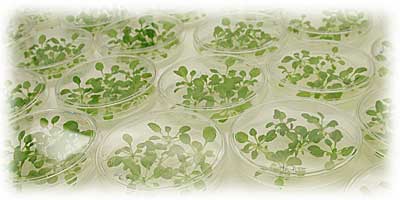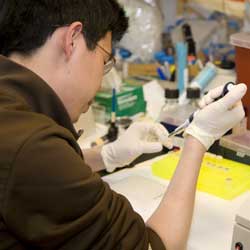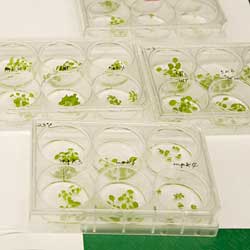 |
|||||||||||||||||
|
|||||||||||||||||
|
Research
We are interested in the elucidation of intracellular signal transduction pathways controlling plant development and defense as well as the creation of new tools for agricultural and environmental improvement. Sugar Sensing and Signaling Our laboratory has been interested in elucidating the molecular mechanisms underlying sugar functions as central signaling molecules in controlling physiology, metabolism, cell cycle, development, and gene expression in plants. Using Arabidopsis thaliana as a model plant, we are elucidating the molecular basis of sugar responses that influence many vital processes in the plant life cycle from germination, root and leaf development, flowering, embryogenesis, to senescence. Using a combination of molecular, cellular, biochemical, genetic and genomic approaches, we have first demonstrated that sugars trigger a global repression of photosynthesis gene transcription in plants. We have further shown that some sugar signals are mediated through the sugar sensor hexokinase (HXK), which has dual functions as an enzyme and as a signal transmitter. Transgenic Arabidopsis plants with altered HXK levels exhibit either sugar insensitivity or hypersensitivity based on the analysis of diverse gene expression and glucose-induced developmental arrest. Auxin Signaling Auxin is an essential plant hormone that regulates diverse processes, such as cell division and expansion, embryogenesis, meristem formation, root and leaf patterning, tropism, and reproduction. Extensive molecular studies have identified a large set of auxin-inducible genes and the auxin-responsive cis-elements and the relevant trans-acting factors. Genetic approaches have led to the isolation of genes involved in auxin responses and transport and the unraveling of protein degradation control in auxin signaling. Our lab has been interested in understanding the molecular and biochemical mechanisms underlying the auxin signal transduction pathway that control nuclear gene transcription and plant morphogenesis. We have taken novel molecular genetic and genomic approaches to identify regulatory genes important for auxin-inducible transcription and morphogenesis by using tobacco and Arabidopsis as model systems. We have established efficient transient and stable transformation systems that will allow the identification of genes that can perturb (both gain of function and loss of function) various steps of the auxin-dependent transcription and morphogenesis, including cell proliferation, elongation, and differentiation. Cytokinin Signaling Pathway Cytokinins are essential plant hormones that control cell division, shoot meristem initia-tion, leaf and root differentiation, chloroplast biogenesis, stress tolerance, and senescence. Together with auxin, another plant hormone, cytokinins can reprogram terminally differentiated leaf cells into stem cells and support shoot regeneration indefinitely in plant tissue culture. Thus, cytokinins are master regulators of plant growth and development, which are highly plastic and adaptive, as well as remarkably resilient and perpetual. ABA and Stress Signal Transduction The plant hormone abscisic acid (ABA) modulates a wide spectrum of responses, including gene activation and repression, guard cell closure, cell cycle blockage, and photosynthesis inhibition, under multiple environmental stress conditions such as drought, cold, and salinity. ABA also plays a pivotal role in the developmental program of seed maturation, desiccation, dormancy, and germination. Our lab is interested in the molecular mechanisms underlying ABA perception and signal transduction from the receptors to the target genes. We have established that isolated mesophyll protoplasts from both maize and Arabidopsis respond to ABA and various stress signals as in intact leaves, thus providing a simple but powerful system to dissect the ABA and stress signal transduction pathways. Although calcium has been implicated as a second messenger in ABA and multiple stress signaling, the calcium sensor and downstream regulatory components have not been identified. Innate Immunity There is remarkable conservation in the recognition of pathogen-associated molecular patterns (PAMPs) by innate immune responses of plants, insects and mammals. We developed an Arabidopsis thaliana leaf cell system based on the induction of early-defense gene transcription by flagellin, a highly conserved component of bacterial flagella that functions as a PAMP in plants and mammals. Here we identify a complete plant MAP kinase cascade (MEKK1, MKK4/MKK5 and MPK3/MPK6) and WRKY22/ WRKY29 transcription factors that function downstream of the flagellin receptor FLS2, a leucine-rich-repeat (LRR) receptor kinase. Activation of this MAPK cascade confers resistance to both bacterial and fungal pathogens, suggesting that signalling events initiated by diverse pathogens converge into a conserved MAPK cascade. The Molecular Basis of C4 Photosynthesis C4 plants partition CO2 fixation in two consecutive steps in the dimorphic photosynthetic cell types, mesophyll and bundle sheath cells, thus concentrating CO2 for more efficient photosynthesis and eliminating energy waste in photorespiration. The acquisition of the C4 pathway enables plants to thrive under severe environmental conditions such as high temperature, high light intensity, and low water availability. We have used the monocot maize as a model system to elucidate the regulatory mechanisms and signaling pathways controlling the genes involved in C4 photosynthesis. Our studies show that pre-existing genes were recruited for the C4 pathway after acquiring new expression features mediated by diverse molecular mechanisms and multiple signal transduction pathways. The simple maize protoplast transient expression assay is currently the most versatile cell system that allows us to analyze the functions of photoreceptors, protein kinases, protein phosphatases, and transcription factors in controlling photosynthesis genes. Various chemical reagents and maize mutants are also used to deduce the steps and components of diverse signal transduction pathways based on reporter gene expression. Transgenic plant studies generally support and extend our findings in cellular systems. We are also exploring the maize single cell system for more powerful applications such as expression cloning and mutant complementation. |
|||||||||||||||||
|
|
|||||||||||||||||
| Copyright © 2006-2012 The Massachusetts General Hospital | |||




